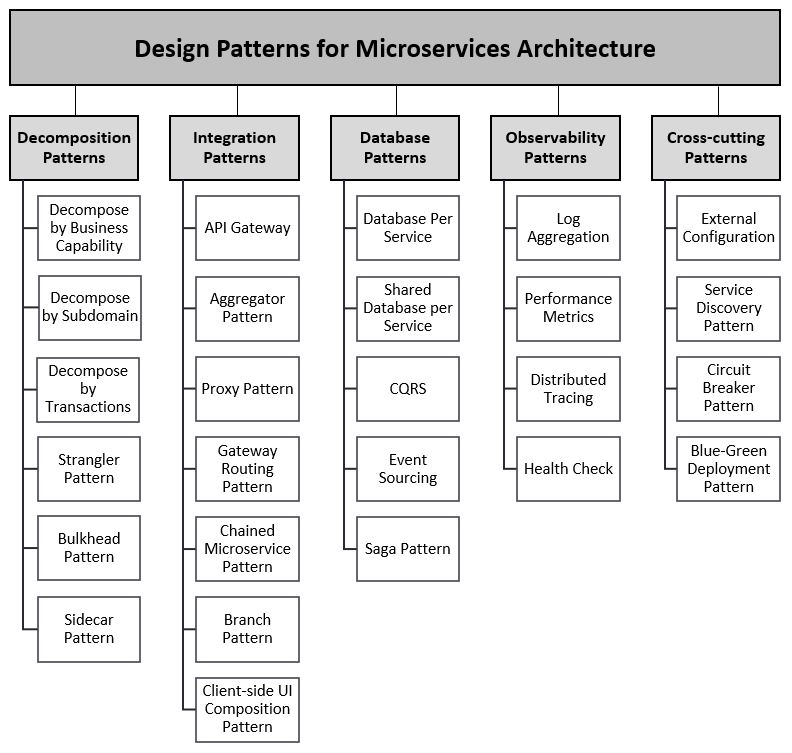Microservice architecture consists of several independent and separate services that communicate with each other in different ways. This article, Introduction to the Microservices Architecture Pattern, explains the microservices architecture. In addition to the advantages mentioned for the microservice architecture and the solutions it provides you, it also brings challenges and problems with it. Basically, the design, development and deployment of such microservices architecture accompanied with challenges such as: Data consistency, Managing shared access, Communication between services, Security of services, and Dependency management. But you should know that these technical challenges, like many problems in this field, can be solved by choosing the right design patterns and appropriate to the problem. In the following, microservice design patterns will be described.
Microservices design patterns
Design patterns are tested and optimal solutions in software development issues. In a word, design pattern is a pattern that should be used in its proper condition to provide the best result in software development. In essense, microservices design patterns are software design patterns that generate reusable autonomous services. The aim is to allow developers who use microservices to accelerate application releases and deploy each microservice independently if needed. Microservice design patterns are generally divided into five main categories. Each of them has its advantages and disadvantages. Figure-1 graphically illustrates various design patterns for microservices.
 Figure-1: Design Patterns for Microservices Architecture
Figure-1: Design Patterns for Microservices Architecture
NOTE: According to the explanations given, each category of microservices design patterns is going to be described in more detail in the series of articles.
Let’s understand each one of them.
Decomposition Patterns
As previously mentioned, there are numerous categories of microservice architecture patterns, however there would be no microservice architecture if one category of patterns did not exist. This category is microservices decomposition patterns, which allow the application to be divided into a collection of loosely coupled services. Indeed, decomposition patterns are used to divide large and small applications into smaller services. You can break down the program based on business capabilities, transactions, or sub-domains (Domain-Driven Design). If you wish to break it down using business capabilities, you will first have to evaluate the nature of the enterprise. Decomposition design patterns include six primary patterns to decomposition which listed below.
Decompose by Business Capability
Decompose by Subdomain
Decompose by Transactions
Strangler Pattern
Bulkhead Pattern
Sidecar Pattern
Integration Patterns
While building and developing a large, complex application using microservice architecture, microservices may use numerous protocols. REST is used by some microservices, while AMQP is used by others. The challenge now is figuring out how to allow clients to access each microservice without worrying about protocols and other complexity. These difficulties are addressed via integration design patterns. For instance, how to get the results of multiple services in a single call, and so on. Integration design patterns include seven primary patterns which listed below.
API Gateway
Aggregator Pattern
Proxy Pattern
Gateway Routing Pattern
Chained Microservice Pattern
Branch Pattern
Client-side UI Composition Pattern
Database Patterns
Database design patterns address issues such as whether each service should have its own database or use a shared database, Separation of command and querie concept, and so on. Microservice design views an application as a collection of loosely coupled microservices, and each service can be developed independently in an agile manner to facilitate continuous delivery/deployment. The database structure/architecture utilized in a microservices-based application is addressed by database design patterns. Database design patterns include five primary patterns which listed below.
Database Per Service
Shared Database per Service
CQRS
Event Sourcing
Saga Pattern
Observability Patterns
Observability design patterns take performance measurements, logging, health, and other aspects into account. Logs can be info, error, warning, or debug. Therefore, this pattern allows users to aggregate logs from all service instances using a centralized logging service. Users can also create alerts for specific text in the logs. This pattern is critical because requests frequently spam many service instances. Observability design patterns address how to use logs to examine and troubleshoot application issues. Observability design patterns include four primary patterns which listed below.
Log Aggregation
Performance Metrics
Distributed Tracing
Health Check
Cross-cutting Patterns
Cross Cutting design patterns address the challengees regarding service discovery, external configurations, deployment scenarios, and so on. Changes in the configuration attributes and properties of the services and databases, for example, may necessitate the developer rebuilding or redeploying the service. With cross-cutting design pattern, you can avoid modifying code to accommodate configuration changes. To make the program load at startup, you can externalize all of the configurations. This design pattern also incorporates the service discovery pattern, which entails constructing a service registry for each service’s metadata. Generally, Cross-cutting patterns are commonly interconnected with infrastructure or third-party services. Infrastructure services include things like a service registry, a message broker, and a database server. Third-party services include payment services, email services, and messaging services. Cross-cutting design patterns include four primary patterns which listed below.
External Configuration
Service Discovery Pattern
Circuit Breaker Pattern
Blue-Green Deployment Pattern
Conclusion
This article discussed the different design patterns in microservices architecture and listed their different types. While microservices design patterns provide numerous advantages, they also present new complications such as service orchestration, distributed system administration, and service-to-service communication. As a result, it’s critical to carefully analyze the design patterns that are acceptable for a given application, taking into account business needs, technical constraints, and the skills of the development team. Microservices design patterns enable enterprises to create software systems that are more flexible, scalable, and resilient.

Comments powered by Disqus.